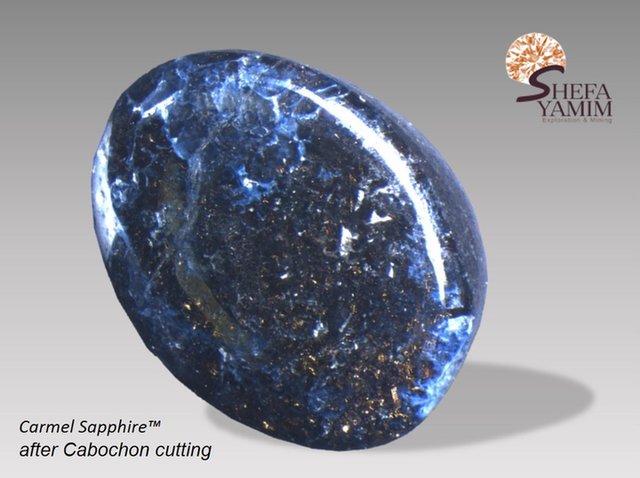COMPANY INSIGHT
Sponsored by: Carroll Technologies
Exploration
Carmeltazite: new gemstone on the block
In 2018, Israeli precious stone exploration company Shefa Yamim announced that it had discovered a new gemstone, the Carmel Sapphire. The gem went through rigorous procedure to determine its uniqueness, before being recognised by the International Mineralogical Association as a new gemstone. So what classifies a gemstone as new? Molly Lempriere finds out


More than half of the country’s coal mines are managed by pro-Russian separatist militia.
Credit: DmyTo/Shutterstock.
Every year as many as 100 new stones are classified by the International Mineralogical Association (IMA). In 2018, these included Camanchacaite, Eddavidite and Stefanweissite amongst many others, bringing the number of known minerals on Earth to over 5,500.
“Before a new mineral species can be established (or redefinitions or changes to nomenclature can be applied) strict procedures need to be followed,” explains IMA secretary Hans-Peter Schertl. “The Commission on New Minerals, Nomenclature and Classification also coordinates the procedures for classification of minerals and groups. The voting members of the commission are providing a tremendously intense service for the IMA in that they evaluate all nomenclature proposals (new minerals, changes in existing minerals, mineral groups).
“If you consider that for instance for the year 2015, 129 proposals for new minerals were handled (of which 121 were approved), equaling about one proposal every three days, you can imagine what kind of time-consuming service this commission is providing. And all the proposals contain for instance information on chemistry, X-ray and optical data, etc., which have to be compared with the data of already existing minerals.”
But one stone stands out. Carmeltazite was discovered in northern Israel and has been designated a rare mineral by the IMA. It is made up of titanium, aluminium and zirconium, together with traces of scandium, calcium and magnesium, forming a complex, crystalline structure.
A standout discovery
Initially it may seem unusual that new stones are still discovered. Geology has been studied for thousands of years, and yet new gemstones like the Carmeltazite are still being discovered.
“One may indeed think that all our minerals, plants, and animals are meanwhile discovered. Regarding new minerals, more and more sophisticated techniques became available during the last years, which allow to study even crystals of a few micron in size,” explains Schertl. “This is a major reason why still a lot of new minerals are discovered. Often some “exotic“ well known mineralogical occurrences are re-investigated after decades of years using such new techniques which often leads to new discoveries.”
Carmeltazite stands out from other recent discoveries for a couple of reasons: firstly, the quantities it has been found in mean that it is commercially viable and secondly, the stone it is most similar to is the only one ever found in an asteroid.
"The stone was discovered by exploration company Shefa Yamim, which is marketing it as the Carmel Sapphire."
The stone was discovered in Israel by exploration company Shefa Yamim, which is marketing it as the Carmel Sapphire. “The unique locality of the Carmel Sapphire, found in the volcanic rocks in Mount Carmel (Primary Source) and in the Kishon Mid Reach (Secondary deposit) in Northern Israel, adds to the rarity of the Carmel Sapphire,” says Shefa Yamim CEO Avi Taub. “It is a wonderful and remarkable discovery, which distinguishes the Carmel Sapphire from any other sapphires in the world.”
Shefa Yamim, together with scientists from Macquarie University, the University of Western Australia, Università degli Studi di Firenze, and Università degli Studi di Milano, Carmeltazite was examined and a report published detailing the new mineral.
The stone was officially recognised by the IMA January 2019, and categorised under the number 2018-103.
“We are delighted that our Carmel Sapphire has been recognised as a host to many rare minerals,”said Shefa Yamim CEO Avi Taub. “In today’s world where the prices of gems are determined predominantly by their rarity, the Carmel Sapphire is a unique discovery because it has not been found anywhere else in the world and was discovered by Shefa Yamim in the soil of the Holy Land.
“We believe this substantially increases the potential value of our ‘Gem Box’ of precious stones. The studies of Carmel Sapphire and its new minerals mark another milestone in the company’s journey as we continue our progress towards trial mining in Zone 1 in 2019.”

Carmel Sapphire after Cabochon cutting.
More than half of the country’s coal mines are managed by pro-Russian separatist militia. Credit: DmyTo/Shutterstock.
The rarest of stones
Named for the mountain in which it was found, Mount Carmel, and the three main components (titanium, aluminium and zirconium), Carmeltazite is found in corundum, an aluminium-oxide. It has a theoretical density of 4.12g/cm³, as much as 0.60g/cm³ more than diamonds.
Carmeltazite was probably formed almost 18 miles beneath the surface of the Earth, near the crust-mantle boundary. It was created by immense heat and pressure leading to reactions between minerals, and then pushed to the surface some 65 million years ago by volcanic eruptions.
"It is chemically most like a mineral known as allendeite, which has only ever been found in the Allende meteorite."
Bizarrely, it is chemically most like a mineral known as allendeite, which has only ever been found in the Allende meteorite. The meteorite fell to Earth on 8 February 1969 in the Mexican state of Chihuahua. It is the largest carbonaceous chondrite, from which two tonnes of material was collected.
“We have seen a huge amount of interest in the Carmel Sapphire since the discovery, and with the value of gemstones often based on their rarity, we believe this newly-discovered mineral has great potential value,” says Yamim.
So far the largest Carmeltazite stone discovered is 5.26 carats, much higher than many newly discovered stones. It is typically black, blue to green and orange-brown in colour, and as such is aesthetically appealing enough for use in jewellery.

